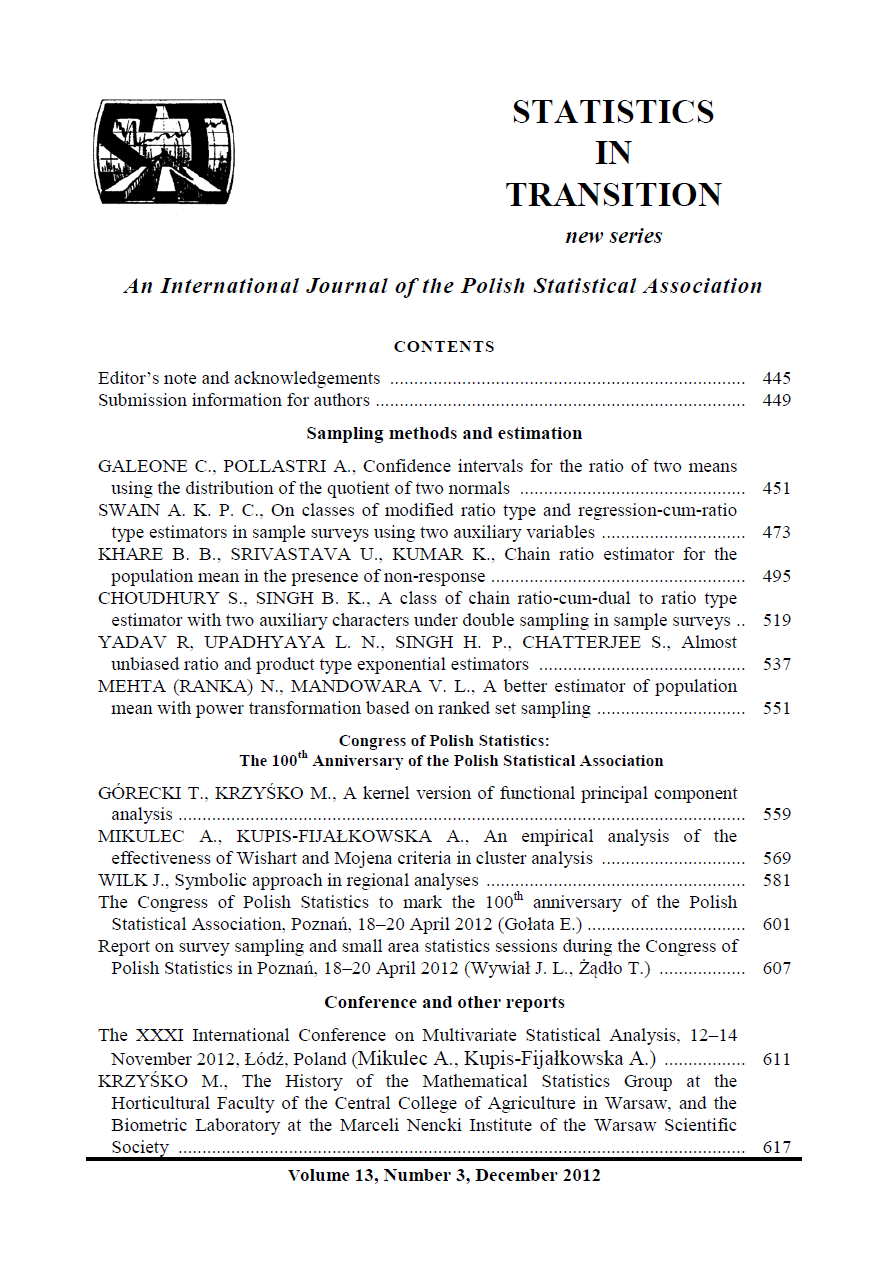ARTICLE
ABSTRACT
Regional studies cover a spectrum of diversified phenomena and problems including social, economic and environmental ones, which refer to territorial units. Owing to their specific characteristics they are most frequently of both multivariate and complex nature. Conducting regional research is associated with the need to consider such difficulties as large data sets, insufficient precision of phenomena description, disregarding territorial diversification of a given phenomenon, as well as incomplete description of problems. The objective of the paper is to suggest solutions to these problems by means of symbolic approach application which basically consists in presenting phenomena in the form of symbolic data. The first part of the paper discusses specific nature of symbolic data, methods for collecting symbolic data and methods for these data analysis. The second part presents an empirical example referring to the assessment of labour market situation in Polish regions (NTS-2) using symbolic data and cluster analysis.
KEYWORDS
symbolic approach, symbolic data analysis, cluster analysis, regional research, labour market.
REFERENCES
BILLARD, L., DIDAY, E. (2006). Symbolic Data Analysis. Conceptual Statistics and Data Mining, Chichester: Wiley.
BOCK, H. H., DIDAY, E. (Eds.) (2000). Analysis of symbolic data. Exploratory methods for extracting statistical information from complex data, Berlin Heidelberg: Springer-Verlag.
BRITO, P. (2004). Clustering Interpretation. Interpreting Clusters by using the module CLINT, In: M. Noirhomme-Fraiture (Ed.), User manual for SODAS 2 software, Software Report, Analysis System of Symbolic Official Data, Project no. IST-2000-25161.
DIDAY, E., NOIRHOMME-FRAITURE, M. (Eds.) (2008). Symbolic data analysis and the Sodas software, Chichester: John Wiley & Sons.
EVERITT, B. S., DUNN, G. (2001). Applied Multivariate Data Analysis, London: Arnold.
HAIR, J. F., BLACK, W. C., Babin, B. J., Anderson, R. E., Tatham, R. L. (2006). Multivariate Data Analysis, New Jersey: Pearson Prentice Hall.
MALERBA, D., ESPOSITO, F., GIOVALLE, V., TAMMA, V. (2001). Comparing Dissimilarity Measures for Symbolic Data Analysis, In: P. Nanopoulos (Ed.), New Techniques and Technologies for Statistics and Exchange of Technology and Know-how (ETK-NTTS'01), conference materials, pp. 473-481.
MALERBA, D., ESPOSITO, F., MONOPOLI, M. (2002). Comparing dissimilarity measures for probabilistic symbolic objects, In: A. Zanasi, C.A. Brebbia, N.F.F. Ebecken, P. Melli (Eds.), Data Mining III, Series Management Information Systems, vol. 6, Southampton: WIT Press, pp. 31-40.
MYNARSKI, S. (2000). Praktyczne metody analizy danych rynkowych i marketingowych [Practical methods for market and marketing data analysis], Kraków: Zakamycze.
Popyt na pracę w 2010 r. [The demand for labour in 2010] (2011). Statistical Information and Studies, Central Statistical Office, Warsaw: Central Statistical Office Publishing House.
WALESIAK, M. (1993). Strategie postępowania w badaniach statystycznych w przypadku zbioru zmiennych mierzonych na skalach różnego typu [Procedures in statistical research in case of variables set measured in different types of scales], Badania Operacyjne i Decyzje [Operational Studies and Decisions] no. 1, pp. 71-77.
WILK, J. (2010a). Metody analizy danych symbolicznych [Symbolic data analysis methods], In: J. Dziechciarz (Ed.), Econometrics 29. The Application of quantitative methods, Research Studies of Wrocław University of Economics no. 141, Wrocław: Wrocław University of Economics Publishing House, pp. 29-38.
WILK, J. (2006b). Miary odległości obiektów opisanych zmiennymi symbolicznymi z wagami [Distance measures for objects described by symbolic variables with weights], In: K. Jajuga, M. Walesiak (Eds.), Taxonomy 13. Data classification and analysis – theory and applications, Research Studies of University of Economics in Wrocław no. 1126, Wrocław: University of Economics in Wrocław Publishing House, pp. 224-236.
WILK, J. (2006a). Problemy klasyfikacji obiektów symbolicznych. Symboliczne miary odległości [Problems of symbolic objects classification. Symbolic distance measures], In: J. Garczarczyk (Ed.), Quantitative and qualitative methods for market research. Measurement and its efficiency, Research Bulletins University of Economics in Poznań no. 71, Poznań: University of Economics in Poznań Publishing House, pp. 69-83.
WILK, J. (2010b.) Problemy segmentacji rynku z wykorzystaniem metod klasyfikacji i danych symbolicznych [Market segmentation problems applying classification methods and symbolic data], Wrocław University of Economics, doctoral dissertation (unpublished), Jelenia Góra.
WILK, J. (2009). Przegląd metod wielowymiarowej analizy statystycznej wykorzystywanych w badaniach segmentacyjnych [The review of multivariate statistical analysis applied in segmentation studies], In: . Dziechciarz (Ed.), Econometrics 23. The Application of quantitative methods, Research Studies of Wrocław University of Economics no. 37, Wrocław: University of Economics in Wrocław Publishing House, pp. 59-70.
WILK, J. (2011). Taksonomiczna analiza rynku pracy województw Polski –podejście symboliczne [Taxonomic analysis of labour market in Polish regions – symbolic approach], In: J. Dziechciarz (Ed.), Econometrics 34. The Application of quantitative methods, Research Studies of Wrocław University of Economics no. 200, Wrocław: Wrocław University of Economics Publishing House, pp. 26-37
